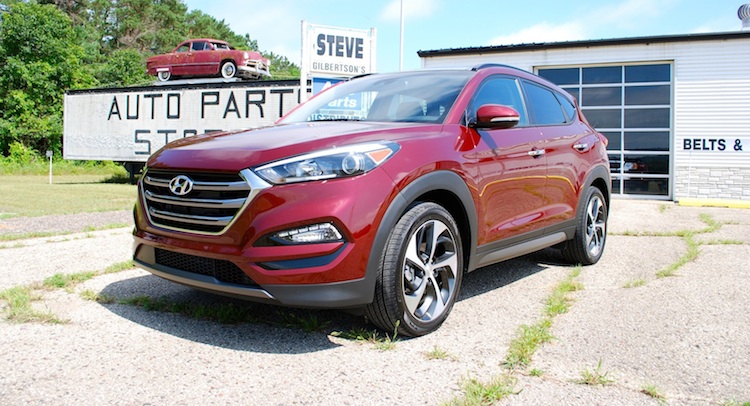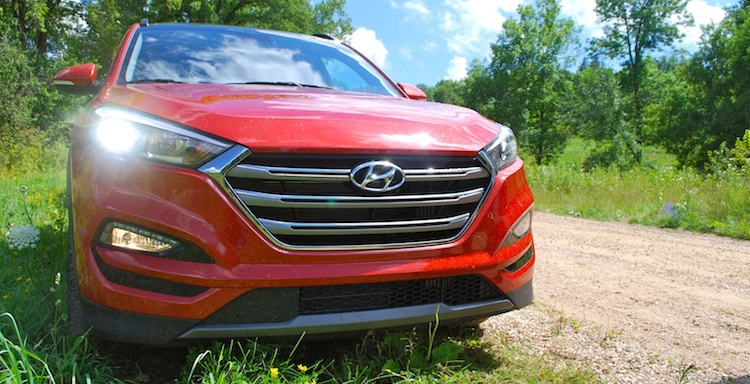There’s nothing “cute-ute” about the 2016 Hyundai Tucson, or any of the other compact SUV leaders. These are the new staples of the American suburbs.
The third-generation Tucson is a prime example of how the segment has grown up in the last decade or so. This is an altogether more refined and expensive entry in a segment that was recently a niche, but is made up of members now outpacing best-selling sedan nameplates. The Tucson wants to be taken seriously now.
It’s somehow fitting Hyundai decided to send us to Minneapolis last week to drive the 2016 Tucson in Minnesota and rural Wisconsin. If the old car was the perky-but-innocuous Laura Petrie from The Dick Van Dyke Show, then the new Tucson is a more independent and confident Mary Tyler Moore getting her own show and moving out to the big city.
For the record, I did not throw my hat into the air at any point on this trip.
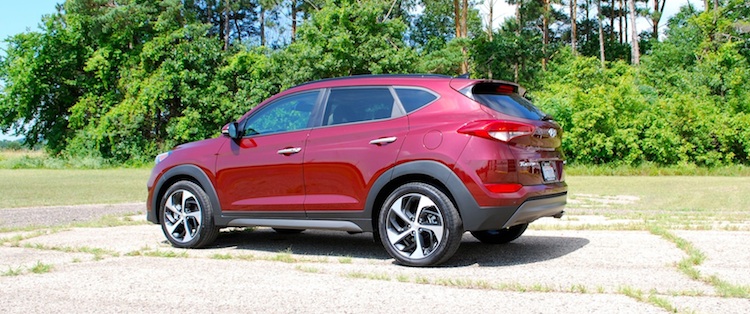
A sharper image
Swoops and curves are out at Hyundai. First the Sonata and Genesis sedans lost the flowing lines of their old models in favor of more adult, squarer shapes when redesigned for 2015. Now the Tucson sheds its old jelly bean-like shape, in favor of a cleaner shape and more muscular physique.
Some of this appearance is helped by the added length and width, which gives the car more presence. The Tucson is substantially longer than the outgoing model, which was on the small side for the class. And the old, smiling grille in favor of a wider, more handsome face. LED running lights up front give the new Tucson angrier eyes than the outgoing car, too.
The 19-inch wheels on Sport and Limited models help the more expensive and aggressive look, as the 17s on SE and Eco trims make the Tucson look a tad under-tired.
Let’s think about that briefly: 17-inch wheels suddenly look small on a $25,000 SUV.
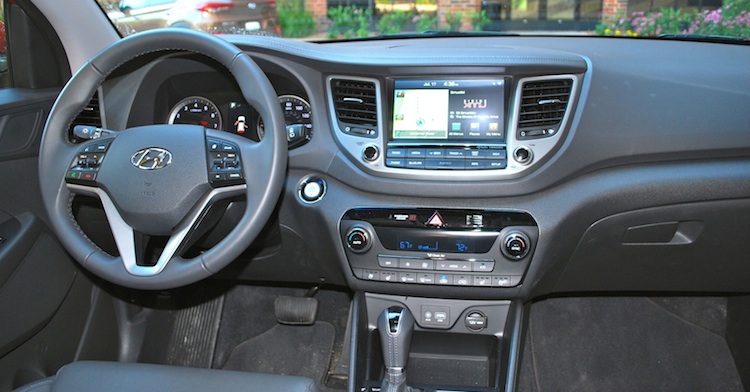
Toy box
My time with the Tucson was primarily confined to the Limited models, most lavish of the four trims and the one which Hyundai believes will make up about 40 percent of the new Tucson’s sales. That’s another tell of how its buyers are going to be more mature and affluent.
There’s a lot more space than in the old Tucson, which is mostly felt in the midsize-like rear seat and extremely generous cargo hold. Seats fold pretty flat when the adjustable cargo floor is moved to its highest level. Despite this feature, there’s still a spare tire.
The Ultimate Package fitted to the cars I drove features an enormous panoramic roof with a much-appreciated powered sunshade does an excellent job of shielding occupants from the sun on hot days. The ventilated front seats also do an excellent job of keeping your backside dry on hot days, for those of you who fear sweaty backs.
Altogether, controls are extremely easy to use. Hyundai’s touchscreen navigation is fairly responsive and the display is bright and clear, too. Neither Android Auto nor Apple CarPlay is offered on the Tucson yet.
Soft-touch materials are used sparingly on the upper dash and there’s a stitched top on upper models, but the overall impression is that the interior is a quality piece. The cloth upholstery on the base SE feels rather utilitarian, but even that base interior is a nicer place to be than a base Honda CR-V or Subaru Forester, for example.
The main disappointment with the Tucson’s interior actually comes from its safety technology. A backup camera is now standard, but many rivals already include that soon-to-be-mandatory feature. While blind-spot monitoring, lane departure warning and rear cross-traffic alert are available and work fine, you have to buy the second-from-highest Sport model to get them.
And only the Limited with Ultimate package can be had with automatic braking, but adaptive cruise control nor any active assists are offered. The CR-V, CX-5 and Escape do better here.
Whereas many cars in the 2016 Tucson’s class – Ford Escape, Honda CR-V, Subaru Forester, Toyota RAV4 – are rooted in compact sedans, the Hyundai is underpinned by a variation of the midsize Sonata platform. This contributes to some of the maturity felt behind the wheel.
Undoubtedly thanks to more high-strength steel and sound deadening in the new Tucson, the Hyundai does a great Volkswagen Tiguan impression, possibly even coming close to an Audi Q5 in feel. On country roads, the Tucson is planted and secure. New are the three driving modes, but the normal setting is good enough for most situations. I do wish, however, the heavier steering from the Sport mode could be mated with the transmission response from Normal.
Only the base SE soldiers on with the old 2.0-liter non-turbo four. I drove both front and all-wheel drive Limited models with the 1.6-liter turbocharged four-cylinder. The powertrain, with its 7-speed dual-clutch automated transmission, is lifted from the Sonata Eco model.
Downsized, turbocharged engines are nothing new in this class, but the Tucson’s engine and transmission is among the best at pretending there’s something bigger and more conventional going on behind the scenes. The engine is remarkably quiet and unconstrained, turbo lag is minimal and the transmission is always in the right gear. It feels vaguely hot hatch-ish – at least with front-drive.
With the popular addition of all-wheel drive, the Tucson is noticeably heavier, with duller powertrain responses. And the transmission hesitates from a dead stop, something that wasn’t apparent on the front-drive cars.
Fuel economy isn’t great if you get the all-wheel drive, either. At 24 city, 28 highway, it takes a hit from the 25/30 on front-drive cars, and the 26/33 of the Eco. Those numbers are good, not great for the class.
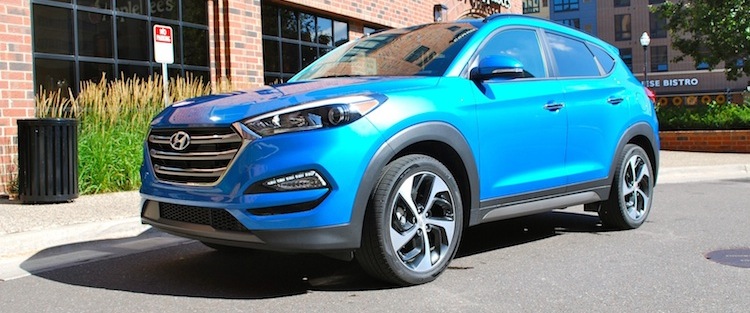
Race to the top
Hyundai averaged about 46,000 Tucsons between 2011 and 2014 without a ton of promotion or incentives, so the fact they want to move 90,000 of the new model every year in a growing segment isn’t overly ambitious.
Pricing is competitive and mostly on top of key rivals. But previous Tucson buyers will notice the new car tops out at some $4,000 more than the old Tucson Limited, nudging $35,000 for a Limited AWD with Ultimate pack. While you get a lot more car for that price increase, it’s yet another reminder Hyundai doesn’t compete for your business by doing closeout deals.
Accept that it’s 2015, though, and a Hyundai badge is just as credible as any other mainstream brand’s sold in the U.S. While Mazda may have the edge on the driving enthusiast market, the Tucson is spacious, well-priced and refined. Most rivals only let you pick two of those three.
And that could be what propels the 2016 Tucson to the top of the compact crossover class – for now, at least. Few brands are struggling here as it becomes more clear that these SUVs are supplanting sedans as the vehicle of choice. The Tucson hits what the market wants right now so squarely that the car that probably needs to watch its back the most is its platform donor, the Hyundai Sonata.
Kids grow up quickly these days.
Hyundai invited to fly me and put me up in a hotel in Minneapolis, and then decided to stuff us all full of Wisconsin cheese and ice cream.
Photos: Zac Estrada / Carscoops



